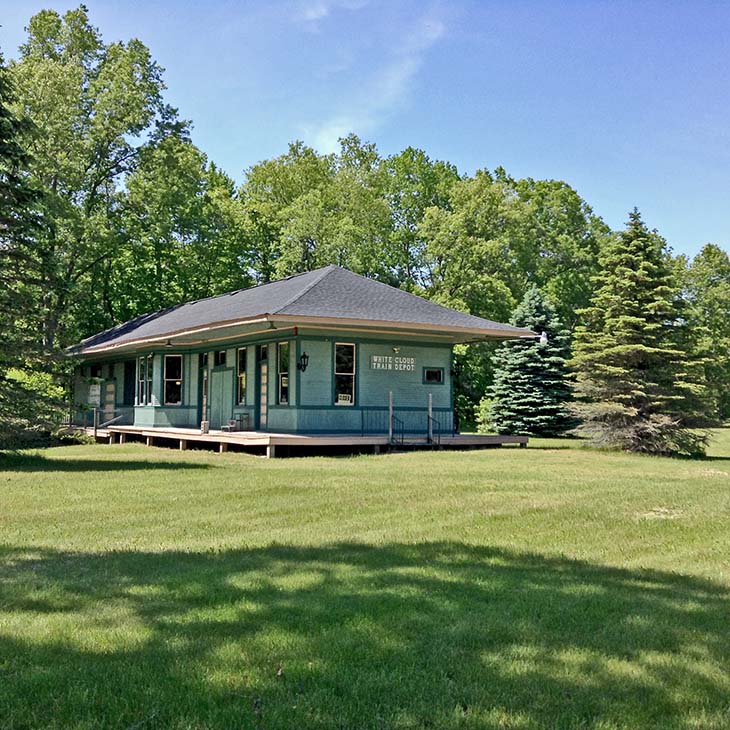

By 1869, businessmen and investors in Grand Rapids presumed that it would be profitable to build a railroad north from Grand Rapids into Michigan’s timber country and then to a port on Lake Michigan. David Clay of Grand Rapids was the chief promoter of the Grand Rapids, Newago and Lake Shore Railroad. By 1872, the investors had funds to lay a line north from Grand Rapids as far as Newago. By 1875, the line was extended to White Cloud. The Chicago and West Michigan was a line that ran north from New Buffalo as far as Pentwater. James Joy, who served for many years as president of the Michigan Central was one of the backer of the Chicago and West Michigan and its predecessor roads. In 1881, the Chicago and West Michigan purchased the Grand Rapids, Newago and Lake Shore and extended its line north reaching Baldwin in 1883 and Traverse City in 1890 and to the Petoskey/Bay View area in 1892.
The Chicago and West Michigan was not the first or only road to serve White Cloud in the 1870s. In 1869, Alexander Morrison incorporated a Chicago and Michigan Lake Shore Railroad to build a line north into west Michigan from a connection with the Michigan Central at New Buffalo. By 1871, he had a line extending from New Buffalo through St. Joseph to Muskegon. In 1872, he purchased the Muskegon and Big Rapids Railroad that was seeking to build a line between those two cities. By 1873, he completed the line to White Cloud. Thus, the Chicago and Michigan Lake shore reached White Cloud two years before the Grand Rapids, Newaygo and Lake Shore. The Chicago and Michigan Lake Shore did not prosper in the 1870s. It went into foreclosure in 1876 and became a part of the Chicago and West Michigan in November, 1878 as a result of a foreclosure sale.
The Chicago and West Michigan, the Flint and Pere Marquette and the Detroit, Lansing and Northern Railroads merged in 1899 to form the Pere Marquette Railroad. This line was purchased by the Chesapeake and Ohio in 1926 and merged into that railroad in 1947. In 1987, the Chesapeake and Ohio became the CSX, an identity it retains today.
The depot you see pictured here was moved to its present site from the roadbed which is about six miles away to the east. It is well maintained and the grounds of a large privately run campgrounds where people may pitch tents or park their motor homes.
The former north-south Pere Marquette line was acquired by the State of Michigan in 1982 when the Chesapeake and Ohio wished to terminate freight service. The operator of the line in 2015 is the Marquette Railroad, a subsidiary of the national rail conglomerate: Geneses’ and Western. The Marquette is now a 126 miles line that uses the former Pere Marquette track as far north as Baldwin. Then tracks of the former Pere Marquette are used to access both Ludington and Manistee.
I do not know when this depot was constructed. I presume that it was built about 1900. Passenger service on the north-south line through White Cloud ended in 1963. For the last thirty or so years of service, the Pere Marquette ran one passenger train a day over the line departing from Grand Rapids about 7 AM and getting to Bay View about 2:30. The train turned around and made a southbound trip arriving in Grand Rapids about 11 PM. While the former Grand Rapids, Newaygo and Lake Michigan remains in operation for freight service, that is not the case for the Chicago and Michigan Lake Shore’s line that once served White Cloud. The line east from White Cloud to Big Rapids was, I believe, abandoned in the late 1920s or early 1930s and the line west from White Cloud to Fremont was abandoned in 1963.
The first settlement at this site was a lumber camp established in 1871. When the Chicago and Michigan Shore arrived, it was given the name Morgan’s Station in honor of Lester Morgan who was one of the founders of the timber operation. It was renamed White Cloud in 1877, was chartered as a village in 1879 and as a city in1950. It is the seat of Newaygo County. The Census Bureau’s 2009-2013 surveys reported 1,433 residents for White Cloud and 48,000 in the county. Newaygo County is named for Chief Naw-wa-goo, a Chippewa leader show signed the Treaty of Saginaw in 1819. Lewis Cass signed for the United States. In this treaty, the Chippewa ceded their claim to about 9400 square miles in central Michigan although two modest areas were reserved for Indians. These are the Isabella reservations; a large one near Mt. Pleasant (about 218 square miles) and a tiny one near Standish (less than one square mile).
Date of construction: Probably shortly after the formation of the Pere Marquette Railroad in 1899.
Architect: Unknown to me
Architectural style: Traditional board and batten railroad depot with bay window facing the tracts
Use in 2015: A facility at a camp grounds
State of Michigan Registry of Historic Sites: Not listed
National Register of Historic Places: Not listed
Photograph: Ren Farley June 3, 2015
Description prepared: June, 2015
Return to Transportation
Return to Homepage